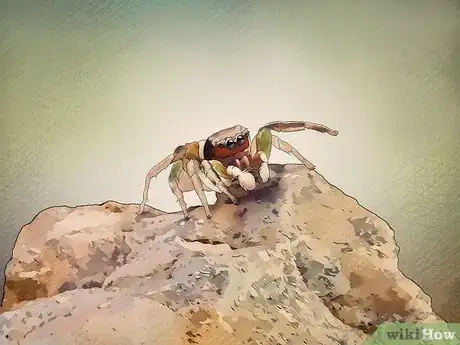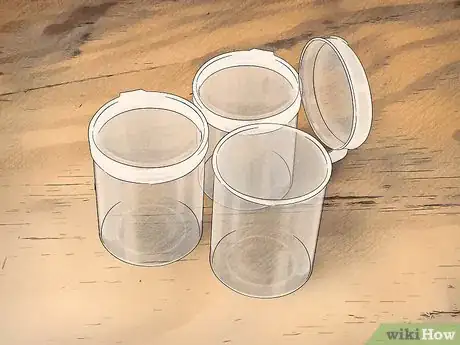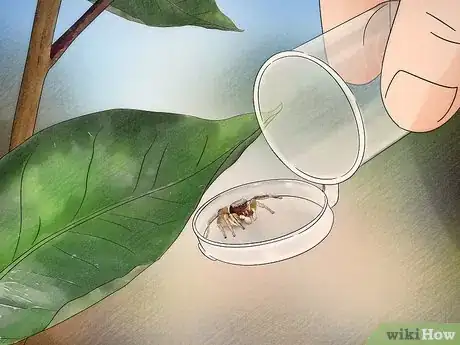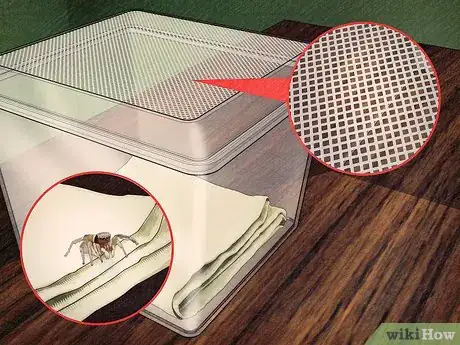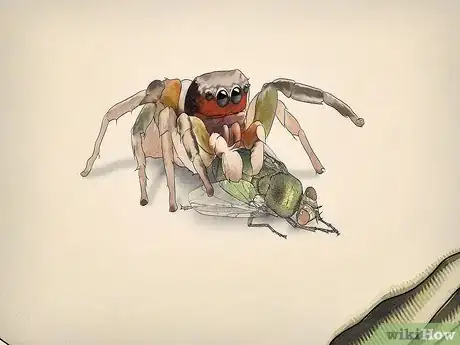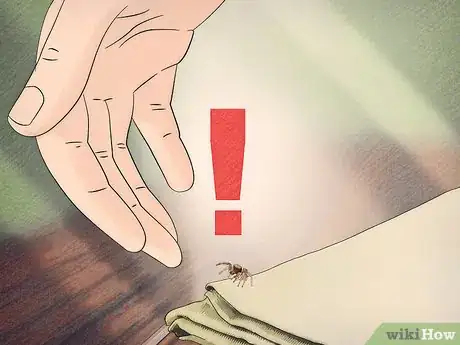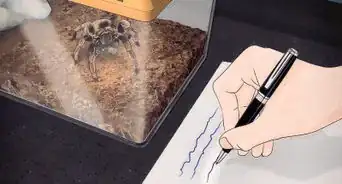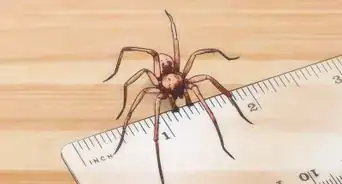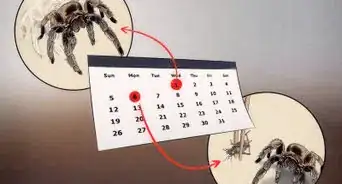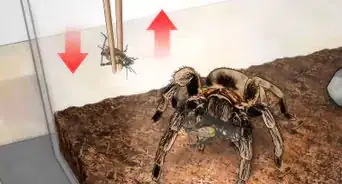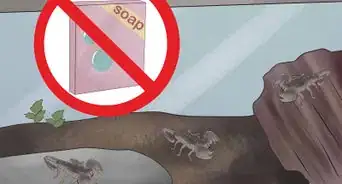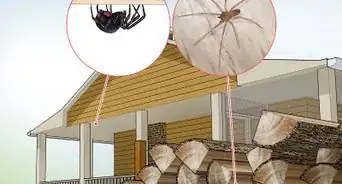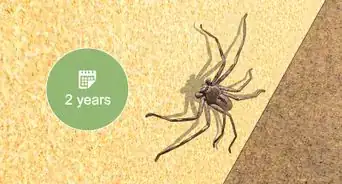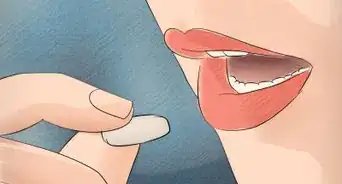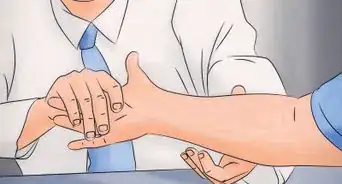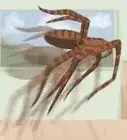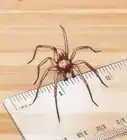This article was co-authored by Pippa Elliott, MRCVS. Dr. Elliott, BVMS, MRCVS is a veterinarian with over 30 years of experience in veterinary surgery and companion animal practice. She graduated from the University of Glasgow in 1987 with a degree in veterinary medicine and surgery. She has worked at the same animal clinic in her hometown for over 20 years.
wikiHow marks an article as reader-approved once it receives enough positive feedback. This article received 16 testimonials and 90% of readers who voted found it helpful, earning it our reader-approved status.
This article has been viewed 226,305 times.
Spiders have earned a bad reputation for being creepy and crawly. But they can actually make really fun and interesting pets. The jumping spider is a good bet. It is not considered dangerous, and it can entertain you with its spectacular hopping skills. Although it can be a fun challenge to hunt and catch this spider, it's important to remember that you're removing the spider from its natural habitat and that this might not be the morally correct thing to do. If you do decide to hunt for a jumping spider in your yard or a nearby park, provide a safe and enjoyable environment for it. Try keeping the spider for only a short time before you release it back into the wild.
Steps
Capturing a Jumping Spider
-
1Recognize a jumping spider. If you want to successfully catch a jumping spider, you need to make sure you know what they look like. Take some time to familiarize yourself with this spider's unique features. That way, you'll know exactly what you are looking for. Jumping spiders:[1]
- Have eight eyes. Two large eyes and two small eyes on its face, and two similar pairs on top of its head.
- May be very colorful. Males might have bands or stripes of vibrant jewel tones on their bodies.
- Have fangs.
- Can appear to be furry or fuzzy.
-
2Track down a jumping spider. Keep your eyes peeled for jumping spiders anytime you are in your yard or garden. These creatures prey on common insects, so they are found in a wide variety of environments. Jumping spiders live in many climates, from tropical jungles to temperate forests.[2]
- It is important to know that jumping spiders do not build webs like many other species of spiders.
- The jumping spider tracks its prey on foot. Look for them jumping or walking in the grass, or hopping from plant to plant.
Advertisement -
3Use beating sticks. You may get lucky and simply spy a jumping spider as it crosses your path. However, in most cases you will need to make a concerted effort to track one down. A beating stick can help you urge a jumping spider out into the open.[3]
- Use a medium length stick as your beater. Carry it with you as you hunt for spiders.
- Use the stick to whack vegetation. For example, when you pass a clump of bushes, gently strike the plants.
- The vibration should cause any hidden spiders to jump out. Be careful not to hit too hard. You don't want to harm any animals who are hiding.
-
4Use a vial to capture the spider. You will need something to contain your spider(s) once you catch one. Vials are an excellent choice. You can carry several vials with you. Look for ones that are at least 2 inches long, so your spider will have plenty of room.[4]
- Either glass or plastic vials will work. Just make sure they come with lids.
- A glass jar or plastic container will also work. Just make sure to wash and dry them thoroughly before hunting for spiders.
-
5Handle the spider carefully. The jumping spider is not thought to be dangerous. However, it is important to note that most experts agree that the venom of these creatures needs to be more thoroughly studied. In short, it is not certain that these spiders are not venomous.[5]
- Use the lid of your jar to gently nudge the spider into the jar. You could also wear thick gloves as an extra layer of safety.
Caring for Your Pet
-
1Create a safe environment. Jumping spiders can thrive in a variety of environments. In order to make sure they have room to jump, try to choose a container that is at least a cubic foot in size. Glass or plastic terrariums work well.[6]
- Make sure the lid is ventilated with small holes so that your spider gets adequate air flow.
- Jumping spiders don't spin webs, but they do enjoy resting in little nests. Provide your spider with material to make a bed. Choose a small piece of cloth, or even a paper napkin.
- Keep the cage out of direct sunlight. You don't want your spider to overheat.
-
2Feed your spider. Your jumping spider will eat a variety of insects. Try feeding it flies and small crickets. If you don't want to collect the food yourself, you can purchase it at most pet stores.[7]
- Your spider does not need to eat every day. It will be fine if you give it an insect every 2-3 days.
- Spiders don't need much water. Just mist the sides of the cage with a spray bottle of water every few days.
- Simply drop the insect into the cage. Your spider will pounce on it and eat.
-
3Interact with your spider. Like most spiders, jumping spiders really don't like to be touched or handled. For the most part, you should avoid trying to handle your spider. If you do need to move him, try to nudge him into a cup using a piece of plastic or other material.
- You can still enjoy your pet. You can watch him jump around his cage. Some will also follow your finger if you gently trace it along the walls of the container. It seems like he may be playing, but it will help you keep him active, and know that he can still see and hunt.
- Occasionally, you can take your spider out of captivity. Set him on your desk and watch him jump. Just be careful not to lose him!
-
4Record your observations. Your spider can be a very interesting pet. Try keeping track of things like how much it eats and when, and if it changes colors or size. You could discover some interesting patterns. You can also track when it likes to sleep.
- Try keeping a small notebook near your jumping spider's cage. That way you'll have it handy when you see it do something interesting.
Warnings
- Don't drop water or food on the spider directly as this can suffocate them. Instead, put food and water in a corner of the cage.⧼thumbs_response⧽
- Stay calm and get medical attention if bitten. Panicking won't help the situation any further.⧼thumbs_response⧽
References
- ↑ https://www.nwf.org/Kids/Ranger-Rick/Animals/Insects-and-Arthropods/Jumping-Spiders.aspx
- ↑ http://www.popsci.com/blog-network/eek-squad/jumping-spiders-are-cutest-and-you-can-catch-your-own
- ↑ http://www.popsci.com/blog-network/eek-squad/jumping-spiders-are-cutest-and-you-can-catch-your-own
- ↑ https://www.youtube.com/watch?v=oZ1P_3fHtPk
- ↑ http://blogs.thatpetplace.com/thatreptileblog/2012/12/18/jumping-spiders-captive-care-new-species-and-a-surprise-they-watch-videos/#.V9xo8igrLIU
- ↑ http://kozmicdreams.com/spidercare.htm
- ↑ http://kozmicdreams.com/spidercare.htm
About This Article
To catch and care for a jumping spider, start by using a medium length stick to whack bushes in your yard, which should cause any hidden spiders to jump out. Once you see a spider, use the lid of a glass jar to gently nudge it into the jar. Next, place the spider in a well-ventilated glass or plastic container that’s at least 1 cubic foot in size with material, like cloth or a paper napkin, for the spider to make a bed. Additionally, feed it 1 insect, such as a fly or small cricket, every other day, and mist the cage with water every 2 to 3 days to keep your spider hydrated. For more tips from our Veterinary co-author, like how to interact with your spider, read on!
